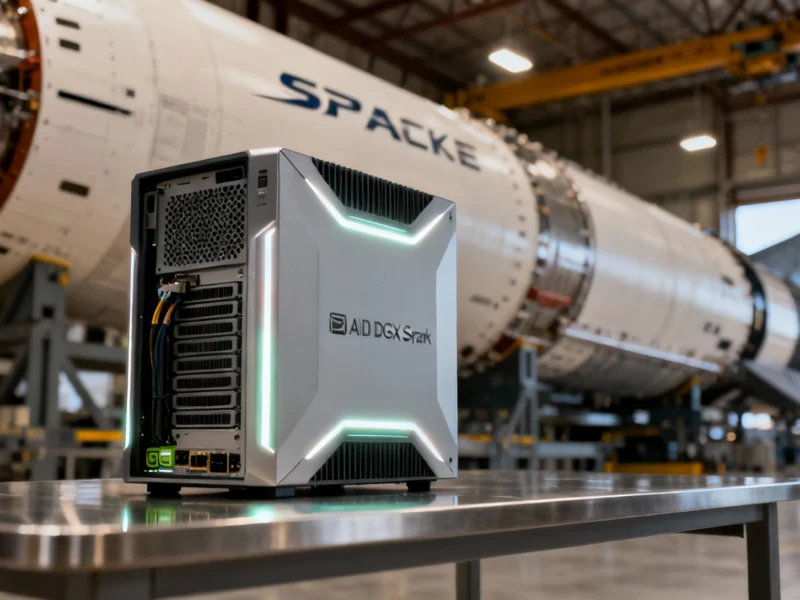In a strategic move highlighting the importance of high-profile partnerships, Nvidia CEO Jensen Huang personally delivered one of the first DGX Spark desktop AI supercomputers to Elon Musk ahead of its official launch. The handoff occurred at SpaceX’s Starbase facility in Texas, creating a powerful visual of cutting-edge AI technology meeting revolutionary space exploration efforts.
The High-Profile Delivery Event
The meeting between the two tech titans took place as SpaceX prepared for the 11th test flight of its Starship rocket, the world’s most powerful launch vehicle. Huang noted the significance of the moment, stating, “Imagine delivering the smallest supercomputer next to the biggest rocket.” The event was documented in Nvidia’s official blog coverage of the DGX Spark delivery, which highlighted the historical context of the moment.
During the meeting, Huang recounted the story of delivering the first DGX system to OpenAI, explaining how the new Spark model advances that original mission. This reference carried particular weight given the well-documented tensions between Musk and OpenAI, raising questions about how the SpaceX CEO received this particular anecdote.
DGX Spark Technical Specifications
Despite its compact form factor, the DGX Spark packs impressive computing power that justifies its “desktop supercomputer” designation. The system features a GB10 Grace Blackwell Superchip that combines a Blackwell GPU with a 20-core Arm-based Grace CPU. This powerful combination is supported by 128GB of unified memory accessible by both processing units and 4TB of high-speed NVMe storage.
The networking capabilities include Nvidia ConnectX for clustering and NVLink-C2C technology that delivers 5x the bandwidth of standard PCIe connections. Despite these enterprise-level features, the 2.6-pound system maintains the convenience of a standard desktop computer with four USB-C ports, Wi-Fi 7 connectivity, and HDMI output, all powered through a standard electrical outlet.
Market Positioning and Availability
Priced at $3,999 excluding local tariffs and taxes, the DGX Spark represents an accessible entry point into high-performance AI computing. The system officially launches on October 15 through Nvidia’s website and retail partners including Micro Center. Multiple versions will be available from manufacturers such as Asus, Dell, Gigabyte, HP, Lenovo, and MSI, providing options for different user requirements and preferences.
The Spark occupies an interesting position in Nvidia’s product lineup, being significantly more affordable than the upcoming DGX Station featuring the more powerful GB300 Grace Blackwell Ultra chip. For context, an Asus ExpertCenter Pro ET900N G3 desktop with similar architecture but offering 20 petaflops of AI performance is expected to retail for over $30,000.
Historical Context and Development Timeline
The DGX Spark’s journey began when it was initially teased as “Project Digits” during CES 2025. The project evolved through Nvidia’s development pipeline before being officially unveiled during the company’s GTC conference in March. The name “Spark” may draw inspiration from Apache Spark, the open-source distributed computing system, though Nvidia hasn’t explicitly confirmed this connection.
Pre-orders opened earlier this year, building anticipation for what Nvidia describes as bringing “data center-level AI capabilities to a desktop or lab environment.” This positioning makes the technology accessible to developers, researchers, and creators who previously required access to large-scale computing infrastructure.
Broader Industry Implications
The timing of this high-profile delivery coincides with significant developments across the technology landscape. Recent industry movements include the merger creating a $19 billion gaming giant and similar consolidation in global gaming markets, demonstrating the rapid transformation occurring across multiple tech sectors.
Meanwhile, other technological breakthroughs are emerging simultaneously, including new discoveries in hydrothermal vent research and advancements in MRAM technology reaching mass production. These parallel developments highlight how AI acceleration through systems like DGX Spark could further accelerate scientific discovery and technological innovation.
Economic and Market Context
The launch occurs against a backdrop of shifting economic conditions, including changing oil market dynamics and evolving currency and trade relationships. Nvidia’s position as the world’s largest company by market capitalization at $4.5 trillion demonstrates the tremendous value the market places on AI technology leadership.
The personal delivery to Musk underscores how Nvidia continues to prioritize strategic relationships despite its massive scale. This hands-on approach to product launches reflects the company’s understanding that in the competitive AI hardware space, high-profile endorsements and partnerships can significantly influence market perception and adoption.
Target Audience and Use Cases
While physically resembling a compact desktop computer, the DGX Spark is specifically engineered for professional users requiring substantial AI processing capabilities. The system delivers one petaflop of AI performance at FP4 precision alongside 200 Gbps high-speed networking, making it suitable for AI model development, scientific research, and content creation workflows that demand substantial computational resources.
The ability to cluster multiple Spark units using Nvidia’s networking technology provides scalability options for organizations needing more power than a single unit can provide. This flexibility positions the system as both an entry point into high-performance AI computing and a building block for larger AI infrastructure deployments.



